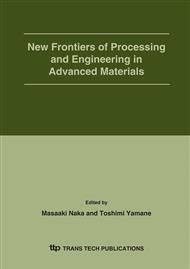p.45
p.51
p.57
p.63
p.69
p.75
p.81
p.87
p.95
Evaluation of Fracture Behavior of Ceramic Composite Joints by Using a New Interface Potential
Abstract:
In order to examine mode-I & II type fracture behavior of ceramic joints, the interface element was proposed as a simple model which represents the mechanism of failure in an explicit manner. It was applied to the analyses of four point bending test and asymmetrical four point bending test for SiC/SiC composite specimen joined by ARCJoinTTM. By using a new type interface potential, which is a coupled function of opening and shear deformations, both the bending and asymmetrical bending tests were simulated. From comparison with experiments, surface energy at the interface between the joint and composite was estimated to be about 30 N/m regardless of the fracture mode. Also, from the comparison between the predicted strength and the experiments for the tensile test of lap joint of SiC/SiC composites, it was found that the proposed method was considered to have a great potential as a tool to study the failure problems whose fracture type was a mixture of mode-I & II.
Info:
Periodical:
Pages:
69-74
Citation:
Online since:
December 2005
Price:
Сopyright:
© 2005 Trans Tech Publications Ltd. All Rights Reserved
Share:
Citation:


